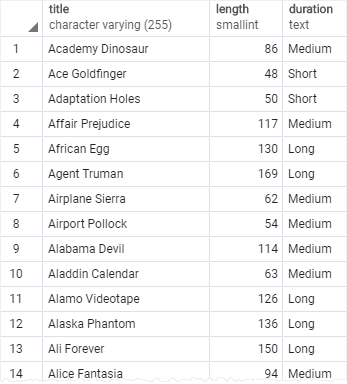August 4, 2023
Summary: in this tutorial, you will learn how to use the PostgreSQL CASE conditional expression to form conditional queries.
Table of Contents
The PostgreSQL CASE expression is the same as IF/ELSE statement in other programming languages. It allows you to add if-else logic to the query to form a powerful query.
Since CASE is an expression, you can use it in any places where an expression can be used e.g.,SELECT, WHERE, GROUP BY, and HAVING clause.
The CASE expression has two forms: general and simple form.
1) General PostgreSQL CASE expression
The following illustrates the general form of the CASE statement:
CASE
WHEN condition_1 THEN result_1
WHEN condition_2 THEN result_2
[WHEN ...]
[ELSE else_result]
END
In this syntax, each condition (condition_1, condition_2…) is a boolean expression that returns either true or false.
When a condition evaluates to false, the CASE expression evaluates the next condition from the top to bottom until it finds a condition that evaluates to true.
If a condition evaluates to true, the CASE expression returns the corresponding result that follows the condition. For example, if the condition_2 evaluates to true, the CASE expression returns the result_2. Also, it immediately stops evaluating the next expression.
In case all conditions evaluate to false, the CASE expression returns the result (else_result) that follows the ELSE keyword. If you omit the ELSE clause, the CASE expression returns NULL.
Let’s take a look at the film table from the sample database.

A) A general CASE example
Suppose you want to label the films by their length based on the following logic:
- If the lengh is less than 50 minutes, the film is short.
- If the length is greater than 50 minutes and less than or equal to 120 minutes, the film is medium.
- If the length is greater than 120 minutes, the film is long.
To apply this logic, you can use the CASE expression in the SELECT statement as follows:
SELECT title,
length,
CASE
WHEN length> 0
AND length <= 50 THEN 'Short'
WHEN length > 50
AND length <= 120 THEN 'Medium'
WHEN length> 120 THEN 'Long'
END duration
FROM film
ORDER BY title;
Output:

Note that we placed a column alias duration after the CASE expression.
B) Using CASE with an aggregate function example
Suppose that you want to assign price segments to films with the following logic:
- If the rental rate is 0.99, the film is economic.
- If the rental rate is 1.99, the film is mass.
- If the rental rate is 4.99, the film is premium.
And you want to know the number of films that belong to economy, mass, and premium.
In this case, you can use the CASE expression to construct the query as follows:
SELECT
SUM (CASE
WHEN rental_rate = 0.99 THEN 1
ELSE 0
END
) AS "Economy",
SUM (
CASE
WHEN rental_rate = 2.99 THEN 1
ELSE 0
END
) AS "Mass",
SUM (
CASE
WHEN rental_rate = 4.99 THEN 1
ELSE 0
END
) AS "Premium"
FROM
film;
The result of the query is as follows:

In this example, we used the CASE expression to return 1 or 0 if the rental rate falls into each price segment. And we applied the SUM function to calculate the total of films for each price segment.
2) Simple PostgreSQL CASE expression
PostgreSQL provides another form of the CASE expression called simple form as follows:
CASE expression
WHEN value_1 THEN result_1
WHEN value_2 THEN result_2
[WHEN ...]
ELSE
else_result
END
The CASE first evaluates the expression and compares the result with each value( value_1, value_2, …) in the WHEN clauses sequentially until it finds the match.
Once the result of the expression equals a value (value1, value2, etc.) in a WHEN clause, the CASE returns the corresponding result in the THEN clause.
If CASE does not find any matches, it returns the else_result in that follows the ELSE, or NULL value if the ELSE is not available.
A) Simple PostgreSQL CASE expression example
The following statement uses the CASE expression to add the rating description to the output:
SELECT title,
rating,
CASE rating
WHEN 'G' THEN 'General Audiences'
WHEN 'PG' THEN 'Parental Guidance Suggested'
WHEN 'PG-13' THEN 'Parents Strongly Cautioned'
WHEN 'R' THEN 'Restricted'
WHEN 'NC-17' THEN 'Adults Only'
END rating_description
FROM film
ORDER BY title;

In this example, we used a simple CASE expression to compare the rating from the film table with some literal values like G, PG, NC17, PG-13 and return the corresponding rating description.
B) Using simple PostgreSQL CASE expression with aggregate function example
The following statement uses CASE expression with the SUM function to calculate the number of films in each rating:
SELECT
SUM(CASE rating
WHEN 'G' THEN 1
ELSE 0
END) "General Audiences",
SUM(CASE rating
WHEN 'PG' THEN 1
ELSE 0
END) "Parental Guidance Suggested",
SUM(CASE rating
WHEN 'PG-13' THEN 1
ELSE 0
END) "Parents Strongly Cautioned",
SUM(CASE rating
WHEN 'R' THEN 1
ELSE 0
END) "Restricted",
SUM(CASE rating
WHEN 'NC-17' THEN 1
ELSE 0
END) "Adults Only"
FROM film;

In this tutorial, you have learned how to use the PostgreSQL CASE expression to form complex queries.

